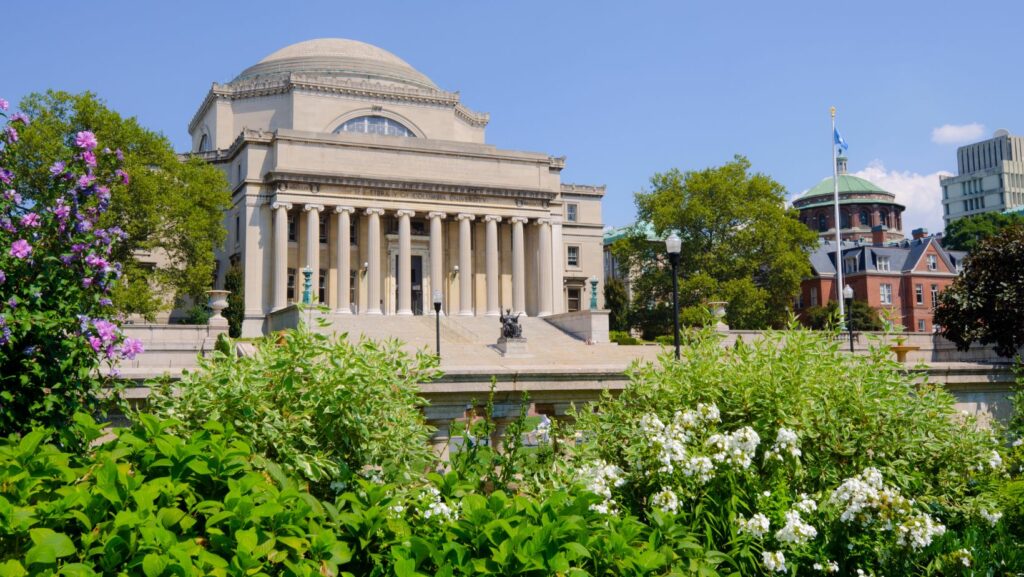Table of Contents
ToggleImmerse yourself in the world of architectural wonders at the New York University (NYU). With a rich history and a reputation for pushing boundaries, NYU’s architecture program stands as a testament to the city’s dynamic architectural landscape.
Join us as we explore the architectural marvels of NYU, delving into its unique design aesthetic, the minds behind these structures, and the impact of its architecture on students and the broader community.
NYU Architecture
The Fusion of Historic and Modern Designs
 NYU’s architecture highlights a harmonious blend of the past and the present. Historic buildings, like the iconic Silver Center, retain their classic facades, offering a glimpse into NYU’s rich historical tapestry. Yet, within, lie modern interiors, equipped with state-of-the-art facilities synonymous with NYU’s continuous strive for innovation. Take, for example, the remarkable renovations at the NYU Law School.
NYU’s architecture highlights a harmonious blend of the past and the present. Historic buildings, like the iconic Silver Center, retain their classic facades, offering a glimpse into NYU’s rich historical tapestry. Yet, within, lie modern interiors, equipped with state-of-the-art facilities synonymous with NYU’s continuous strive for innovation. Take, for example, the remarkable renovations at the NYU Law School.
Championing a sustainable future, NYU incorporates eco-friendly designs and green spaces in its architectural narrative. With its award-winning University Center, NYU sets a high bar for sustainability. The building’s design reduces energy consumption by 30%, emphasizing passive design strategies, and harnesses renewable energy sources.
Key Buildings and Structures at NYU
Considered cornerstones of the NYU campus, the Bobst Library, Kimmel Center for University Life, and 370 Jay Street signify NYU’s architectural richness expressed through their unique characteristics and design elements.
The Iconic Bobst Library
Stands tall as NYU’s primary library, the Elmer Holmes Bobst Library, often referred to as Bobst Library. Philip Johnson, a renowned architect, applied his expertise to design this facility, which opened its doors in 1973. The library flaunts an impressive 12-story structure boasting open-stack access to collections, something that subtly portrays NYU’s commitment to academic openness.
The Kimmel Center for University Life
Next on this architectural journey, one encounters the Kimmel Center for University Life— a student hub known for its modern design and student-centric amenities. NYU commissioned world-class architect Kevin Roche to design this building, opened in 2003. Known for its massive glass facade, the Kimmel Center provides breathtaking views of Washington Square Park and the NYC skyline beyond.
The Innovative 370 Jay Street
370 Jay Street symbolizes the university’s innovative spirit with its reinvented use and future-focused design. The former MTA building, redesigned by Mitchell Giurgola Architects, became operational as an NYU facility in 2017. Now, it houses NYU’s Center for Urban Science and Progress (CUSP), and other NYU science departments, with a design that promotes collaborative research and creative exchanges.
Architectural Influences and Styles
The Impact of Urban Context on NYU Architecture
The influence of the city’s urban environment prominently shapes the architecture of NYU. Being at the heart of Manhattan, it’s absorbed the dynamism of the city, mirroring it in its structures. Examples of this influence feature in the open-concept design of Bobst Library, representing the ever-flowing stream of knowledge. The high-rise structure is reminiscent of the city’s skyline, and its extensive windows assure constant interaction with the urban landscape.
Architectural Inspirations at NYU
 Beyond its urban influences, NYU’s architecture also owes its diversity to multiple architectural inspirations. Philip Johnson’s Brutalist style clearly inspires Bobst Library, ushering in a bold aesthetic that complements the academic space with its strong and utilitarian features.
Beyond its urban influences, NYU’s architecture also owes its diversity to multiple architectural inspirations. Philip Johnson’s Brutalist style clearly inspires Bobst Library, ushering in a bold aesthetic that complements the academic space with its strong and utilitarian features.
On the other hand, the Kimmel Center, displaying modernist design principles, captures the progressive spirit of NYU students. It’s glass facade and open spaces, maximize natural light and facilitate views of Washington Square Park, welcoming the ethos of openness and community within the university.
The Role of NYU Architecture in Student Life
Creating an Inviting Campus Atmosphere
New York University’s architectural design contributes significantly to cultivating a welcoming campus environment. Nestled in the bustling cityscape, the University’s structures create a serene refuge for its student community. For instance, the modernist Kimmel Center, with large glass windows and expansive views of Washington Square Park, serves as the heartbeat of student life. It’s a place where students can relax and unwind between classes, offering a calmer contrast to the city’s usual intensity.
Need to Know
NYU’s architecture is a testament to its commitment to innovation, sustainability, and the creation of engaging learning spaces. While it’s faced challenges in harmonizing expansion with community needs and modern architectural demands, it’s shown a dedication to dialogue and compromise. Its vision is shaped by the need for environmental sustainability and inclusivity, as seen in the eco-friendly design of 370 Jay Street.
